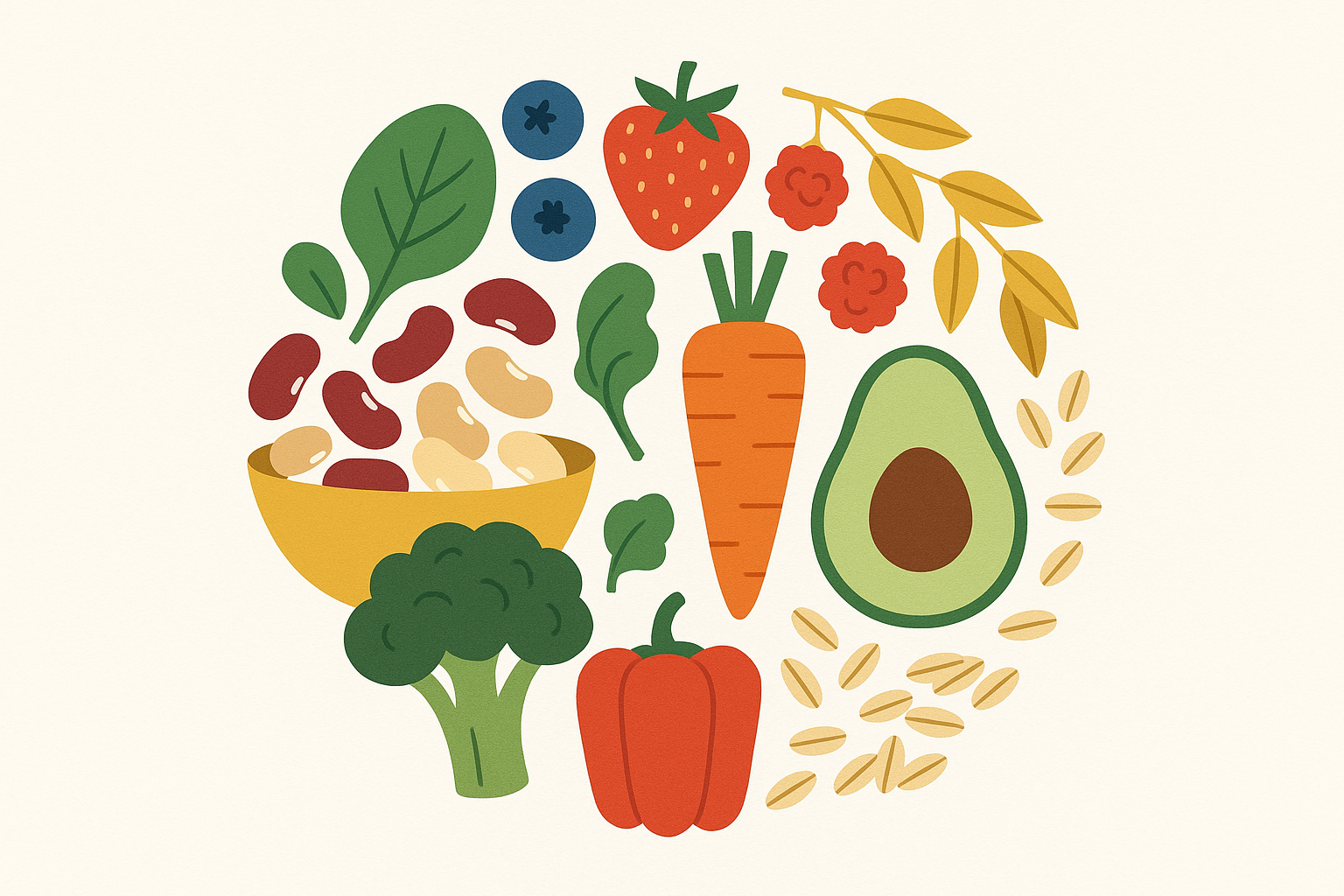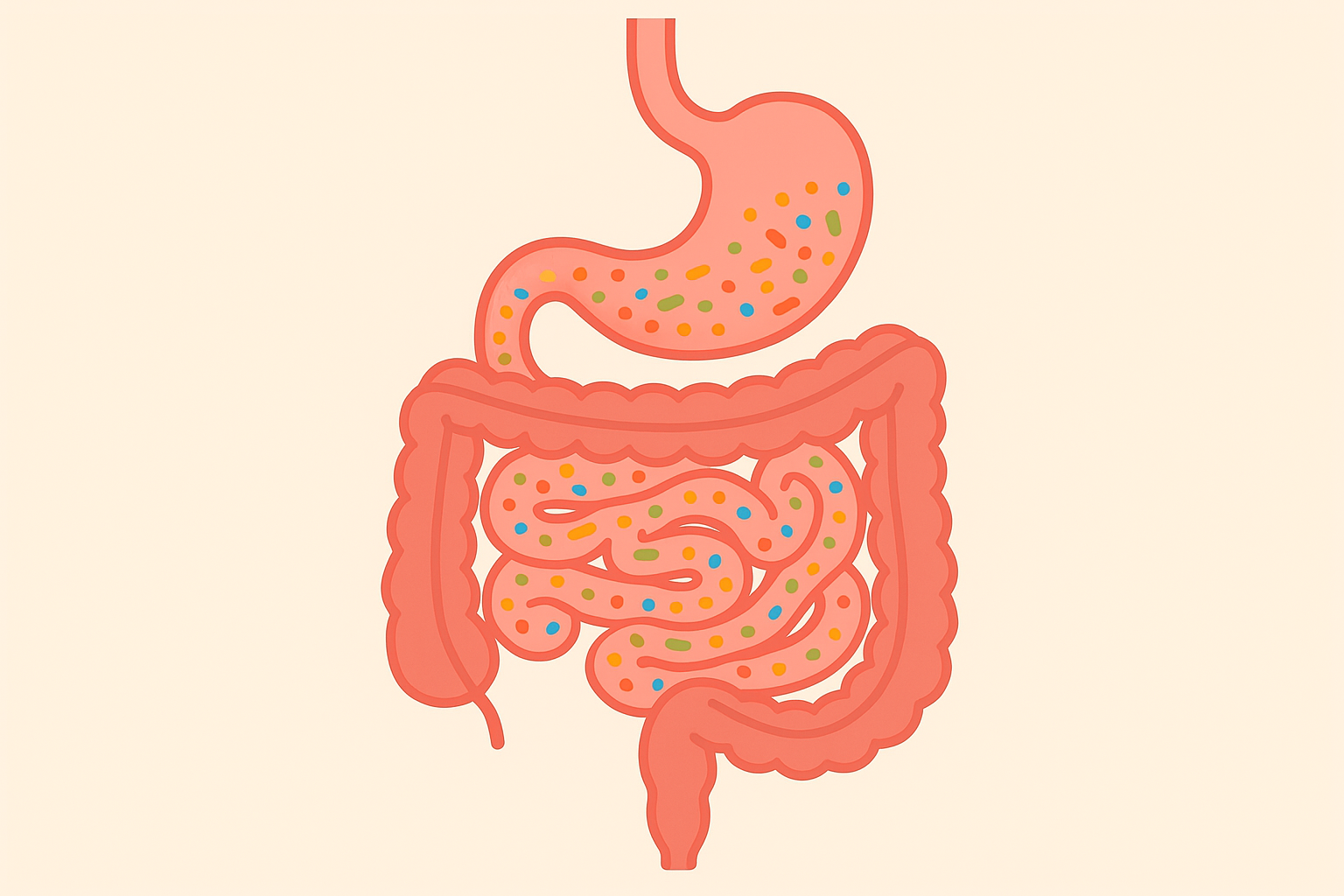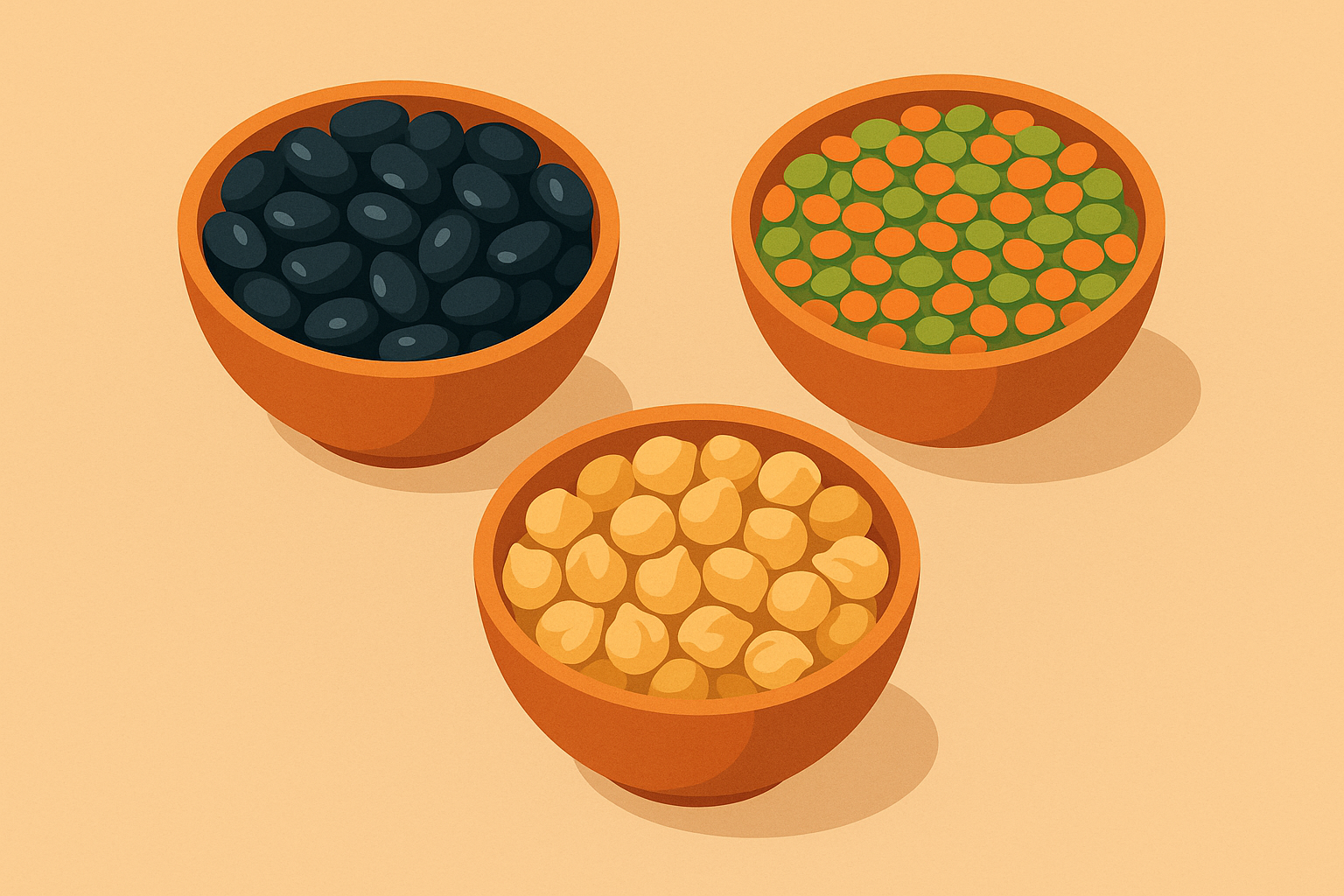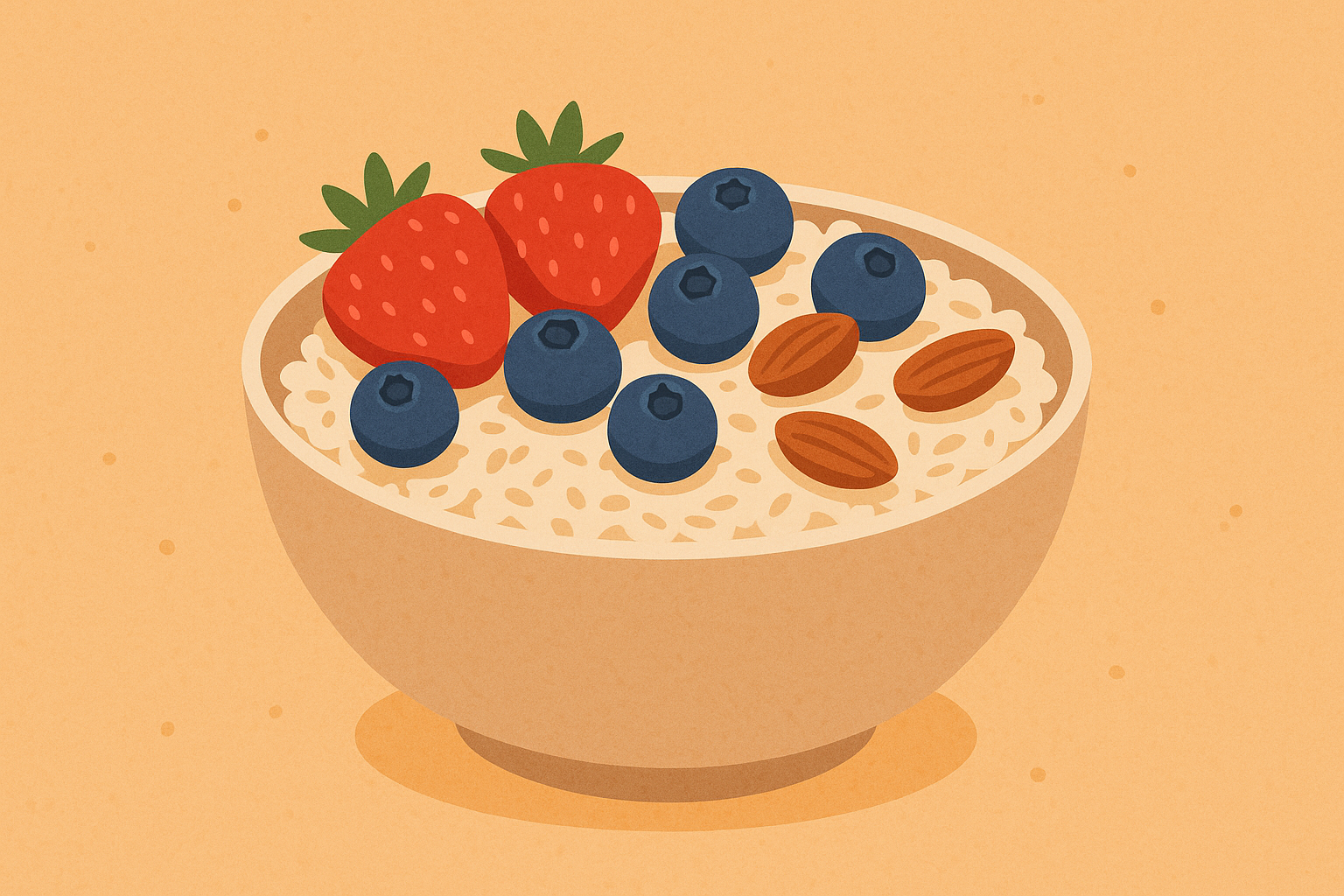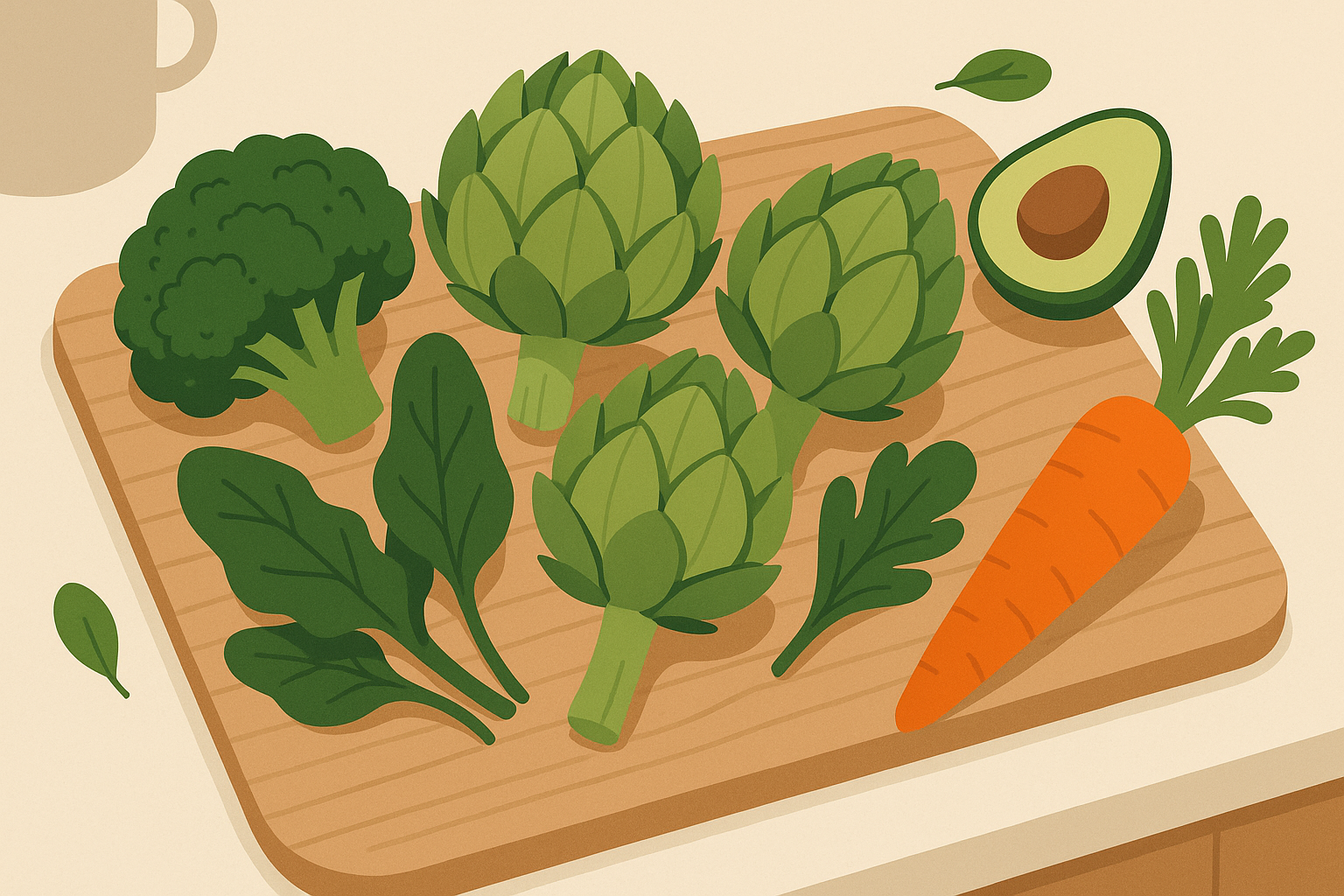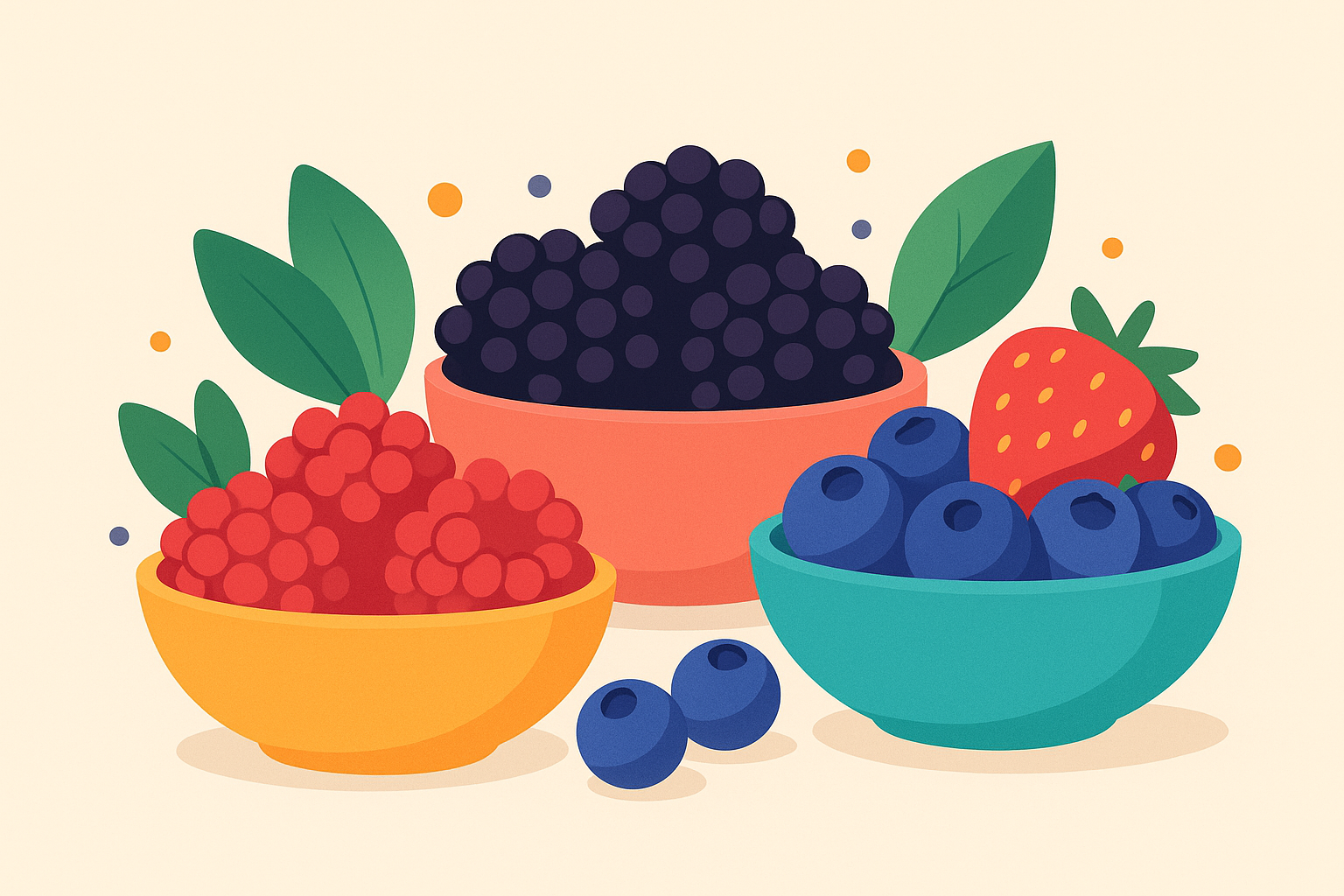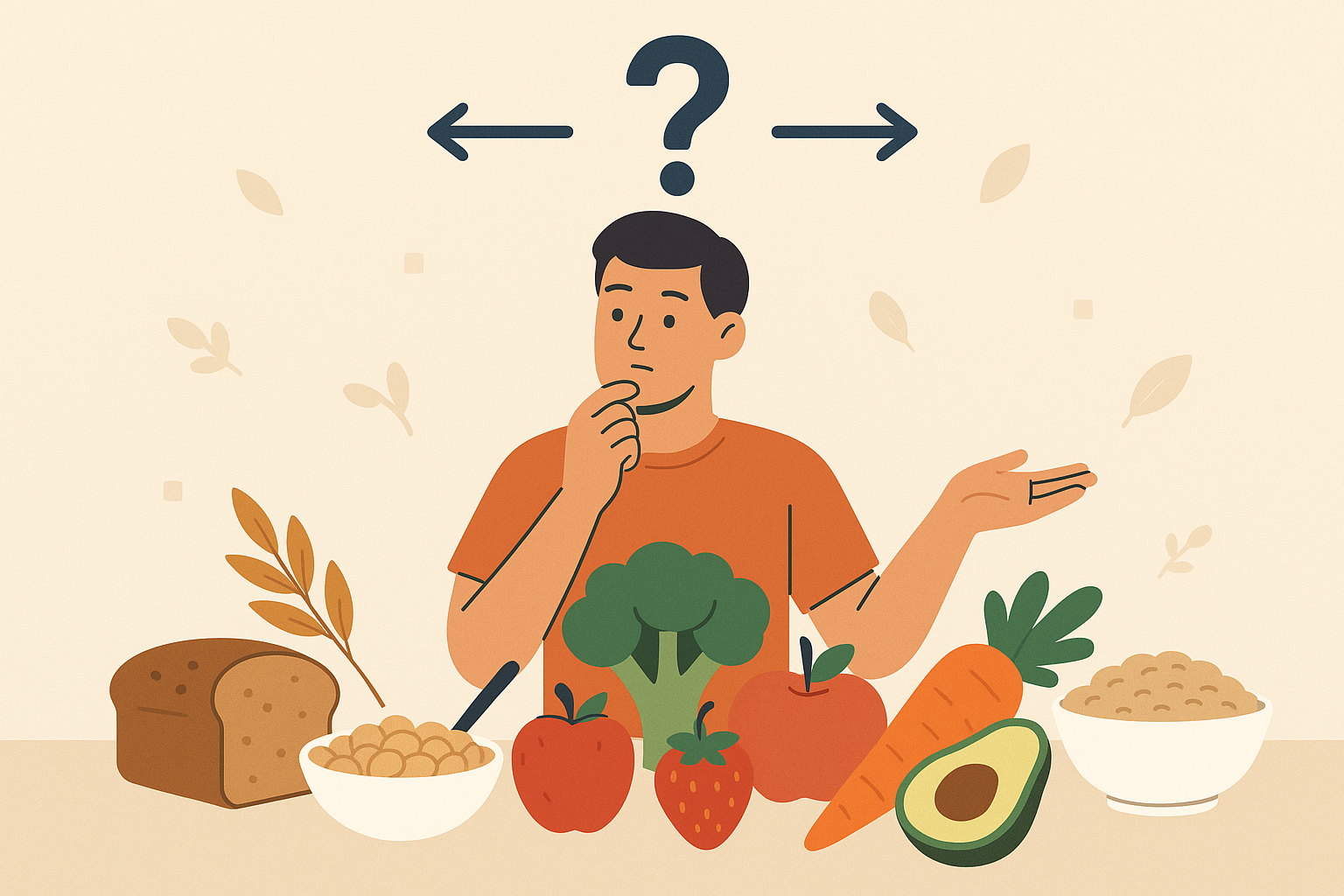25 High-Fiber Foods That Actually Help You Lose Weight (Science-Backed List)
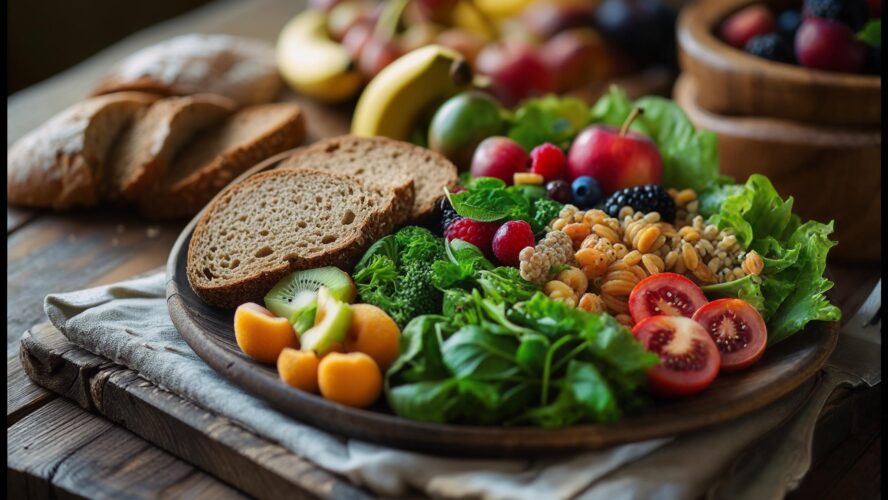
I used to be that person constantly raiding the pantry two hours after eating a “healthy” salad. Sound familiar? Turns out, I was missing one crucial piece of the puzzle: fiber. According to the U.S. Department of Agriculture’s Dietary Guidelines, getting enough fiber is important for overall health, including heart and digestive health.
The difference was life-changing: instead of reaching for snacks every two hours, I found myself naturally eating less while feeling more energized. My cravings disappeared, and I stopped obsessing over my next meal because I actually felt full for once.
You’re about to discover 25 high-fiber foods for weight loss that can transform your approach to sustainable weight management. I’ve tested these foods myself and here’s what actually works. This isn’t another boring list you’ve seen everywhere else – it’s your roadmap to working with your body’s natural hunger signals instead of fighting against them.
Table of Contents
- What Makes High-Fiber Foods Effective for Weight Loss
- 25 High-Fiber Foods for Weight Loss
- Powerhouse Legumes & Pulses (Foods 1-5)
- Whole Grains & Ancient Grains That Satisfy (Foods 6-10)
- Fiber-Rich Vegetables for Volume (Foods 11-15)
- Fruits That Fill You Up (Foods 16-20)
- Seeds & Nuts for Sustained Energy (Foods 21-25)
- How to Choose the Right High-Fiber Foods for Your Goals
- Making High-Fiber Foods Work in Your Daily Routine
- Final Thoughts
TL;DR
- High-fiber foods promote weight loss through increased satiety, reduced calorie absorption, and improved blood sugar control
- The most effective options combine fiber with protein or healthy fats for maximum satisfaction
- Legumes and pulses offer the highest fiber content per serving, with black beans and lentils leading the pack
- Steel-cut oats provide exceptional blood sugar stability through beta-glucan fiber
- Raspberries and blackberries deliver the most fiber among fruits with minimal calories
- Chia seeds and psyllium husk offer concentrated fiber that expands in your stomach
- Start slow to prevent digestive drama when increasing fiber intake
- Drink plenty of water with high-fiber foods to maximize their weight loss benefits
What Makes High-Fiber Foods Effective for Weight Loss
Understanding why fiber is so good for your health goes beyond weight loss – it supports your entire digestive system and overall wellness. When I first started researching high-fiber foods, I was amazed to discover how they work on multiple levels to support weight management.
Here’s the thing about fiber – it basically tricks your stomach into thinking you’re full. Some types dissolve and get gooey (like oatmeal), others stay rough and keep things moving (if you know what I mean). Both help you eat less without feeling deprived. Fiber physically takes up space in your stomach, triggering those “I’m full” signals to your brain. Meanwhile, the soluble stuff forms a gel that slows digestion, keeping you satisfied longer.
Here’s what I look for when choosing fiber-rich foods:
| What I Check For | Why It Matters | Foods That Win | Foods That Don’t |
|---|---|---|---|
| Does it actually fill me up? | No point if I’m hungry an hour later | Black beans, chia seeds, avocados | Fruit juices, refined cereals |
| Can I afford it and find it easily? | Exotic superfoods gathering dust don’t help anyone | Canned beans, frozen berries, oats | Fancy imported grains, specialty items |
| Will my stomach handle it? | Some high-fiber foods can be… rough at first | Oats, bananas, cooked vegetables | Raw cruciferous vegetables (for some) |
| Is it actually convenient? | I’m not spending hours in the kitchen every day | Canned beans, frozen berries, oats | Exotic grains, complicated prep |
| Does it pack other good stuff? | Might as well get vitamins while I’m at it | Sweet potatoes, quinoa, berries | Processed fiber supplements |
| Will it spike my blood sugar? | Crashes make me hangry | Steel-cut oats, legumes, vegetables | Sweetened fiber bars |
Satiety Factor: Your Natural Appetite Control
This is the big one – how long does the food actually keep you full? High-fiber foods that expand in your stomach and slow digestion are your best friends here. When I eat a bowl of black beans with quinoa, I’m genuinely satisfied for 4-5 hours. Compare that to a bagel, which leaves me hungry again within two hours despite having similar calories.
Foods that combine fiber with protein or healthy fats are the real winners. It’s like having a slow-release energy system instead of a sugar rush and crash.
Calorie Density: Maximum Fiber, Moderate Calories
This measures how much fiber you get for your calorie “budget.” The goal is feeling full on fewer calories while still getting the good stuff your body needs. A cup of raspberries gives you 8 grams of fiber for just 64 calories, while an ounce of almonds provides 4 grams of fiber but costs you 164 calories. Both are good, but raspberries win if you’re watching calories closely.
Digestive Impact: How Your Body Actually Handles It
Different fiber types affect your digestive system in unique ways. Some people handle raw vegetables beautifully, while others need to cook them first to avoid bloating and discomfort. I learned this the hard way after a particularly ambitious raw kale salad incident.
Fair warning – beans can make you gassy at first. Yes, your family might complain. Start small, be patient, and maybe warn people about the bean situation.
Practical Accessibility: Foods You’ll Actually Eat
The best high-fiber food is one you’ll eat consistently. I’ve learned that exotic superfoods mean nothing if they sit unused in your pantry. Canned black beans might not sound as exciting as goji berries, but they’re the ones that actually make it into my weekly meals.
This considers prep time, storage, cost, and whether you can actually find the stuff at your regular grocery store without taking out a second mortgage.
Nutrient Density: Fiber Plus Other Good Stuff
Why settle for just fiber when you can get vitamins and minerals too? Sweet potatoes don’t just provide fiber – they’re packed with beta-carotene, potassium, and vitamin C. You’re getting more bang for your caloric buck.
Blood Sugar Impact: Steady Energy Without the Crash
Foods that provide fiber along with complex carbohydrates help maintain steady energy levels and reduce those “I need chocolate NOW” cravings. High-fiber foods with added sugars or refined ingredients don’t make the cut, even if their total fiber content looks impressive.
25 High-Fiber Foods for Weight Loss
These high-fiber foods have been carefully selected based on their ability to actually help with sustainable weight loss. Each category offers unique benefits, from the protein-packed satisfaction of legumes to the low-calorie volume of vegetables.
Powerhouse Legumes & Pulses
Legumes and pulses are basically the heavyweight champions of the fiber world. These protein-packed powerhouses combine serious fiber content with plant-based protein for satisfaction that lasts. Most options in this category give you 12-16 grams of fiber per cooked cup while being budget-friendly and versatile.
The combination of high fiber and protein makes legumes particularly effective for weight loss. They keep you full longer than most other foods, and they don’t mess with your blood sugar like refined carbs do.
1. Black Beans
Fiber content: 15g per cup cooked
Black beans are my secret weapon against the 3 PM snack attack. One cup keeps me full until dinner, and they’re cheap enough that I don’t feel guilty buying them organic. Plus, they taste good with literally everything – tacos, salads, even scrambled into eggs when I’m feeling adventurous.
At 227 calories per cup, they pack 15g of protein along with that fiber. They’re loaded with folate, magnesium, and iron, making them a nutritional powerhouse. You can buy them dried for pennies or canned for convenience – both work great.
My lazy lunch hack: Dump whatever black beans are left in the fridge over some microwaved quinoa, add whatever vegetables didn’t go bad this week, and squeeze lime over everything. Takes 3 minutes and actually tastes good.
2. Lentils (Red, Green, Brown)
Fiber content: 15-16g per cup cooked
I used to think lentils were health food for people who shopped at co-ops and made their own granola. Turns out, they’re just beans that cook faster and don’t need soaking. Game changer for busy weeknights.
At just 230 calories per cup, they provide 18g of protein along with iron, folate, and potassium. Different colors do different things: red lentils disappear into soups and sauces, green ones hold their shape in salads, and brown ones work in hearty stews.
The first time I made a huge pot of lentil soup, I thought I’d be eating it for weeks. Instead, my family devoured it in two days because it actually tasted good and kept everyone full.
3. Chickpeas (Garbanzo Beans)
Fiber content: 12g per cup cooked
Chickpeas are the Swiss Army knife of legumes. You can turn them into creamy hummus, crunchy roasted snacks, or hearty curry ingredients. At 269 calories per cup, they deliver 15g of protein and are packed with manganese and copper.
Roasted chickpeas have become my go-to crunchy snack. Toss drained chickpeas with olive oil and whatever spices you have, then roast at 400°F for 20-30 minutes. They satisfy that need for something crunchy without the empty calories of chips.
4. Split Peas
Fiber content: 16g per cup cooked
Split peas offer one of the highest fiber contents among legumes and they’re dirt cheap. They last forever in your pantry and cook relatively quickly compared to whole dried beans. At moderate calories, they provide 16g of protein per cup along with potassium and vitamin K.
They work beautifully in traditional split pea soup, but you can also blend them into veggie burgers or use them as a protein-rich side dish. Your digestive system usually handles them well too.
5. Lima Beans
Fiber content: 13g per cup cooked
Lima beans get a bad rap from childhood trauma, but give them another chance. They’re naturally creamy and substantial, with 13g of fiber and decent protein at 216 calories per cup. You can find them frozen, canned, or dried, making them accessible year-round.
They work well in succotash, casseroles, or as a protein-rich side dish. The complex carbohydrates provide steady energy without blood sugar roller coasters.
Whole Grains & Ancient Grains That Satisfy
This category features grains that provide 4-10 grams of fiber per cooked cup while offering sustained energy and versatile meal applications. These grains are great for blood sugar stability and actually fit into real-life cooking routines.
Discover how to cook delicious oatmeal every time to maximize the weight loss benefits of this fiber-rich breakfast staple. The key is understanding how different preparation methods affect both fiber content and how full you feel afterward.
| Grain Type | Fiber (per cup cooked) | Calories | Cooking Time | What I Use It For |
|---|---|---|---|---|
| Steel-Cut Oats | 8g | 166 | 20-30 min | Breakfast that actually lasts |
| Quinoa | 5g | 222 | 15 min | Rice substitute that doesn’t crash me |
| Bulgur Wheat | 8g | 151 | 10-15 min | Quick pilaf base |
| Barley (Hulled) | 10g | 193 | 60-90 min | Soups, when I have time |
| Brown Rice | 4g | 218 | 45 min | Meal prep staple |
6. Steel-Cut
6. Steel-Cut Oats
Fiber content: 8g per cup cooked
Steel-cut oats are like the grown-up version of instant oatmeal. They actually keep you full until lunch instead of leaving you hungry by 10 AM. The beta-glucan fiber forms a gel-like consistency in your stomach that signals “I’m satisfied” to your brain.
At 166 calories per cup, they’re budget-friendly and surprisingly versatile. I meal prep them on Sunday nights, cooking a big batch while watching Netflix. During the week, I just reheat with a splash of milk and add fresh berries. It’s transformed my mornings from rushed to actually nourishing.
You can even make them savory with vegetables and herbs if sweet breakfast isn’t your thing. Their chewy texture and nutty flavor provide way more satisfaction than the mushy instant stuff.
7. Quinoa
Fiber content: 5g per cup cooked
I used to think quinoa was pretentious health food for people who shop at Whole Foods. Turns out, it’s just rice that takes less time to cook and doesn’t make me crash two hours later. Who knew?
While lower in fiber than some options, quinoa’s complete protein profile (8g per cup) combined with fiber creates serious satisfaction. This gluten-free grain cooks in 15 minutes and works as an excellent rice substitute in pretty much everything.
It adapts to both sweet and savory preparations, so you can use it in salads, grain bowls, stuffed vegetables, or even breakfast porridge.
8. Bulgur Wheat
Fiber content: 8g per cup cooked
Bulgur is basically pre-cooked wheat that’s been dried and cracked, which means it’s extremely practical for quick meals. Often you just need to soak it in hot water rather than actually cooking it. At 151 calories per cup, it provides 8g of fiber with a chewy texture that’s genuinely satisfying.
It’s perfect for tabbouleh and pilafs, but also works well in grain salads, stuffed vegetables, and as a rice substitute. The low glycemic index helps maintain steady blood sugar levels without the afternoon crash.
9. Barley (Pearl and Hulled)
Fiber content: 6-10g per cup cooked
Barley provides excellent satiety through its beta-glucan fiber content, similar to oats. Hulled barley offers more fiber than pearl barley but takes longer to cook. Both varieties are budget-friendly and add serious substance to meals.
The chewy texture is really satisfying, and the mild flavor adapts to various seasonings. Pearl barley cooks faster (30-40 minutes) while hulled barley requires patience (60-90 minutes) but provides superior nutrition. Great in soups, salads, and as a rice substitute.
10. Brown Rice
Fiber content: 4g per cup cooked
Look, brown rice isn’t the highest in fiber, but it’s highly practical as a staple grain. It’s widely available, familiar to most people, and easy to prepare in large batches for meal prep. Sometimes the best food is the one you’ll actually eat consistently.
The 4g of fiber per cup, combined with manganese and selenium, makes it a decent choice when portioned appropriately. Its moderate glycemic index makes it suitable for blood sugar management, and it serves as an excellent base for grain bowls and stir-fries.
Fiber-Rich Vegetables for Volume
These vegetables provide 3-10 grams of fiber per serving while offering exceptional calorie density and high water content. They’re perfect for creating satisfying, low-calorie meals that actually fill you up without breaking your calorie budget.
For optimal nutrient absorption, consider these simple ways to beat bloat and improve digestion when incorporating more foods that are high in fiber into your diet. Trust me, proper digestion makes all the difference when you’re adding more fiber.
11. Artichokes
Fiber content: 10g per medium artichoke
Artichokes are fiber superstars with just 60 calories for a medium one. They’re packed with vitamin C, folate, and powerful antioxidants. While they require some prep skills, frozen artichoke hearts give you year-round access without the fuss.
The first time I ate a whole steamed artichoke, I was amazed at how much time it took to eat and how full I felt afterward. The act of pulling off each leaf and scraping the flesh with your teeth naturally slows down your eating pace – built-in portion control.
You can steam whole artichokes for an interactive eating experience, or use hearts in salads, pasta dishes, and Mediterranean-inspired meals. They also provide prebiotic benefits that support gut health.
12. Brussels Sprouts
Fiber content: 4g per cup cooked
Brussels sprouts used to be the vegetable kids hid under mashed potatoes. Then I learned to roast them properly, and everything changed. At just 56 calories per cup, they provide 4g of fiber plus 3g of protein.
Fair warning – these can make you gassy. Start with small portions and maybe don’t eat them before a first date. But once your stomach adjusts, they’re actually addictive when roasted with a little bacon or paired with nuts and dried fruits.
They’re available fresh or frozen year-round and cook quickly. Shredding them raw creates excellent slaws that add crunch to any meal.
13. Broccoli
Fiber content: 5g per cup cooked
Broccoli is the reliable friend of vegetables – always there when you need it, affordable, and genuinely good for you. At 55 calories per cup, it’s loaded with vitamin C, vitamin K, and sulforaphane, which has potential anti-inflammatory properties.
It’s widely accessible and versatile in preparation methods. You can steam it, roast it, stir-fry it, or eat it raw with dips. The high water content helps with satiety, and its low glycemic index supports stable blood sugar levels.
14. Cauliflower
Fiber content: 3g per cup cooked
While moderate in fiber, cauliflower’s versatility as a low-calorie substitute makes it valuable for weight loss. At only 29 calories per cup, it provides excellent volume when prepared properly.
It’s become my go-to rice substitute, mashed potato alternative, and even pizza crust base. The mild flavor adapts to whatever seasonings you throw at it, making it a versatile weight loss tool that doesn’t feel like deprivation.
15. Sweet Potatoes
Fiber content: 4g per medium baked potato
Sweet potatoes are proof that healthy food doesn’t have to taste like cardboard. At 112 calories per medium potato, they’re higher in calories than other vegetables but packed with beta-carotene, potassium, and vitamin C.
Their natural sweetness satisfies cravings while providing steady energy. They store well at room temperature and cook easily – baked, roasted, or spiralized into noodles for lower-calorie pasta alternatives.
Fruits That Fill You Up
This fruit category showcases options providing 4-10 grams of fiber per serving while offering natural sweetness and high water content. These fruits are perfect for satisfying sweet cravings while supporting your weight loss goals.
These great hydrating foods for summer include several high fiber fruits that support both weight loss and proper hydration. The combination of fiber and water content makes these fruits particularly effective for appetite control.
16. Raspberries
Fiber content: 8g per cup
Raspberries are fiber superstars disguised as dessert. At just 64 calories per cup, they pack 8g of fiber plus vitamin C, manganese, and powerful antioxidants. They’re like nature’s candy that actually helps you lose weight.
While expensive fresh, frozen varieties provide practical year-round access without sacrificing nutrition. They work beautifully in smoothies, yogurt parfaits, and as natural dessert toppings. The low sugar content means they won’t spike your blood sugar like other fruits.
17. Blackberries
Fiber content: 8g per cup
Similar to raspberries, blackberries provide exceptional fiber with just 62 calories per cup. They’re slightly more durable when fresh, making them more practical for everyday snacking, and they’re usually a bit cheaper too.
My kids call them “nature’s caviar” because of how they pop in your mouth. Frozen options provide year-round access at lower costs, and they work excellently in smoothie bowls or mixed into oatmeal.
18. Apples (with skin)
Fiber content: 4g per medium apple
Apples are the ultimate portable fiber source. At 95 calories per medium apple, they’re packed with pectin fiber that helps regulate blood sugar levels. The key is eating them with the skin on – that’s where most of the fiber lives.
They’re extremely practical – no prep required, available year-round, and they travel well. The natural sweetness and satisfying crunch make them ideal for curbing cravings between meals. Pair them with nut butter for added protein and you’ve got a snack that will actually hold you over.
19. Pears (with skin)
Fiber content: 6g per medium pear
Pears offer more fiber than apples with their high water content at 102 calories per medium pear. They’re packed with vitamin C and potassium, and they require zero preparation beyond washing.
The soluble fiber supports digestive health and helps manage cholesterol levels. When perfectly ripe, they’re incredibly sweet and satisfying. They work well sliced into salads or paired with cheese for balanced snacks.
20. Avocados
Fiber content: 10g per medium avocado
Avocados provide exceptional satiety through their unique combination of 10g fiber, 21g healthy fats, and 3g protein. Yes, they’re higher in calories (234 per medium avocado), but the satisfaction factor makes them valuable for weight management when portioned appropriately.
They’re practical as they ripen at room temperature and work in both sweet and savory applications. The monounsaturated fats support heart health while the fiber aids digestion. Use them in salads, smoothies, on toast, or as a creamy addition to various dishes.
Seeds & Nuts for Sustained Energy
This final category presents concentrated fiber sources that provide 4-10 grams of fiber per ounce or serving. While calorie-dense, these options offer exceptional satiety through their combination of fiber, healthy fats, and protein.
Learn more about why dietary fiber is the real macronutrient you need to watch for optimal health and weight management. Understanding fiber’s role helps you make smarter choices about incorporating these foods into your routine.
21. Chia Seeds
Fiber content: 10g per ounce (2 tablespoons)
Chia seeds are like tiny sponges that expand in your stomach. Despite being calorie-dense (137 calories per ounce), their fiber, protein (4g), and omega-3 content provide lasting satisfaction that prevents overeating later.
My kids call chia pudding “frog eggs” but they still ask for it every morning. Mix 2 tbsp chia seeds with 1/2 cup almond milk, 1 tsp vanilla, and a drizzle of honey. Refrigerate overnight. This 180-calorie breakfast provides 10g fiber and keeps you full until lunch.
They have an excellent shelf life and can be added to virtually anything without changing the flavor. Mix them into smoothies, yogurt, or oatmeal for an instant fiber boost.
22. Flaxseeds (Ground)
Fiber content: 8g per ounce
Ground flaxseeds provide excellent fiber along with omega-3 fatty acids at 151 calories per ounce. They must be ground for optimal absorption – whole flaxseeds just pass right through you (learned that the hard way).
They’re affordable and can be added to smoothies, yogurt, or baked goods without significantly changing taste. Store ground flaxseeds in the refrigerator to prevent the oils from going rancid.
23. Almonds
Fiber content: 4g per ounce
While moderate in fiber, almonds provide excellent satiety through their combination of fiber, protein (6g), and healthy fats (14g). At 164 calories per ounce, research shows people don’t absorb all the calories due to their structure.
Yes, nuts are healthy. No, you can’t eat the whole bag while watching TV. I portion them into small containers because apparently I have zero self-control around almonds. Pre-portioning is key for weight management.
24. Psyllium Husk
Fiber content: 5g per teaspoon
I tried psyllium husk once without enough water. Big mistake. Learn from my digestive distress and always, ALWAYS drink plenty of water with it. This nearly pure fiber supplement is extremely low in calories (18 per tablespoon) and forms a gel that significantly slows digestion.
It’s used as a supplement mixed into water or smoothies, or in baking as an egg substitute. Start with small amounts and increase gradually to avoid uncomfortable bloating.
25. Coconut (Shredded, Unsweetened)
Fiber content: 7g per ounce
Unsweetened shredded coconut provides good fiber along with medium-chain triglycerides at 185 calories per ounce. It adds tropical flavor to dishes and has an excellent shelf life
Unsweetened shredded coconut provides good fiber along with medium-chain triglycerides at 185 calories per ounce. It adds tropical flavor to dishes and has an excellent shelf life.
Use it sparingly in smoothies, yogurt, or baked goods for flavor and texture enhancement. The natural sweetness can satisfy cravings without added sugars, but portion control is important due to the calorie density.
How to Choose the Right High-Fiber Foods for Your Goals
Your weight loss journey is unique, and the most effective high-fiber foods are the ones you’ll actually eat consistently. Don’t stress if you hate half these foods. I can’t stand chickpeas but love black beans. Find your favorites and stick with them – variety is nice, but consistency is what actually works.
Consider your current digestive tolerance when introducing new high-fiber foods. If you’re not used to eating much fiber, start with gentler options like oats, bananas, and cooked vegetables before moving to higher-fiber legumes and raw vegetables. This gradual approach prevents the uncomfortable digestive drama that might derail your efforts.
Think about your lifestyle and cooking preferences. Busy professionals might gravitate toward quick-cooking options like lentils and quinoa, while those who enjoy meal prep might prefer batch-cooking beans and grains. There’s no single “best” approach – only what works consistently for your situation.
Build on foods and flavors you already enjoy rather than forcing yourself to eat things you dislike. If you love smoothies, chia seeds and berries become obvious choices. Prefer hearty soups? Lentils and vegetables will be your best friends.
Making High-Fiber Foods Work in Your Daily Routine
Successfully incorporating high-fiber foods requires strategic planning and gradual implementation. Don’t try to eat all 25 of these foods tomorrow. Pick two that sound good, try them for a week, and see how you feel. Small changes add up to big results – I promise.
For additional support with meal planning, explore these intuitive eating principles that can help you naturally incorporate more fiber-rich foods into your daily routine. The goal is creating sustainable habits rather than following rigid rules.
| Daily Fiber Goals | What This Looks Like | Sample Daily Menu |
|---|---|---|
| Week 1: 20-25g | Add 1 high-fiber food | Oatmeal + berries, apple snack, brown rice dinner |
| Week 2: 25-30g | Add beans/lentils | Previous + lentil soup lunch |
| Week 3: 30-35g | Add more vegetables | Previous + extra vegetables at meals |
| Week 4: 35g+ | Find your rhythm | Balanced high-fiber meals throughout day |
Here’s my realistic meal prep: I cook a big batch of something on Sunday while watching Netflix. Usually beans or lentils because they’re hard to mess up. Then I eat them all week in different ways until I get sick of them and cook something else. It’s not Instagram-worthy, but it works.
Sunday confession: I’m lazy about meal prep. But even I can dump a can of beans into a container with some leftover quinoa and call it lunch for three days. Cook 3 cups each of quinoa, black beans, and roasted vegetables. Portion into 6 containers with different seasonings (Mediterranean, Mexican, Asian). Each container provides 12-15g fiber and serves as a complete meal base.
Hydration becomes crucial when you increase fiber intake. Drink plenty of water to prevent constipation and maximize satiety benefits. Aim for at least 8 glasses daily, and consider herbal teas as additional fluid sources.
Combine high-fiber foods strategically for maximum impact. Think black beans with quinoa, apple slices with almond butter, or chia seed pudding with Greek yogurt. These combinations provide sustained energy and satisfaction that lasts.
Timing matters too. Eating high-fiber foods earlier in the day can help control appetite throughout the day. Starting with a fiber-rich breakfast sets a positive tone and may reduce overall calorie intake at later meals.
At Organic Authority, we understand that sustainable weight loss isn’t about restriction – it’s about nourishing your body with clean, whole foods that naturally support your goals. When you choose organic, sustainably-sourced versions of these high-fiber foods, you’re not only supporting your weight loss journey but also voting with your dollar for a healthier food system. Ready to transform your approach to weight management? Start with our curated selection of organic, high-fiber foods that align with your wellness goals and values.
Final Thoughts
For those interested in a more comprehensive approach to healthy eating, consider exploring Dr. Mark Hyman’s 5 rules for a truly healthy breakfast to complement your high-fiber food choices.
Look, I’m not going to pretend that switching to black beans will magically solve all your weight problems. But after three months of eating them regularly, I stopped thinking about food every two hours. That’s pretty life-changing.
The journey toward sustainable weight loss doesn’t require extreme measures or complicated rules. These 25 high-fiber foods offer a proven approach that works with your body’s natural hunger and satiety signals rather than fighting against them. The beauty lies in their ability to provide genuine satisfaction while supporting your weight management goals through increased fullness, improved digestion, and steady energy levels.
Remember that success depends not on perfection, but on consistency. Focus on progress over perfection, and celebrate small victories along the way. Start with the options that appeal to you most, whether that’s creamy avocados, hearty lentils, or sweet berries. As you discover which high-fiber foods you genuinely enjoy, you can gradually expand your repertoire and increase your overall fiber intake.
Your success depends not on perfection, but on consistency. Focus on progress over perfection, and celebrate small victories along the way. Each high-fiber food you incorporate brings you closer to a sustainable, satisfying approach to weight management that honors both your health goals and your taste preferences. The path to lasting weight loss is paved with nourishing choices that make you feel energized, satisfied, and confident in your journey toward optimal wellness.

